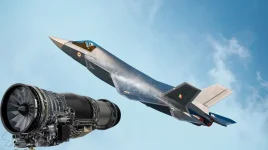- Views: 9K
- Replies: 7
India's long-standing ambition for self-reliance in critical aerospace technology is advancing, as the Gas Turbine Research Establishment (GTRE) is in the final stages of completing a new jet engine testing facility.
Located in Rajanukunte near Bengaluru, this advanced site is designed to support the development of crucial indigenous military power plants.
The facility, which began construction in September 2023, is a 130-kilonewton (kN) Twin Engine Test Bed. Officials project that with interior work concluding over the next eight months, the entire complex will be fully operational by October 2025.
This timeline positions the facility to play a central role in validating two key projects: the Dry Kaveri engine for unmanned combat drones and a new, more powerful engine for the future Advanced Medium Combat Aircraft (AMCA).
As a key laboratory of the Defence Research and Development Organisation (DRDO), GTRE has designed the Rajanukunte site to be a cornerstone of India's indigenous defence manufacturing ecosystem.
Recent satellite images confirm the presence of a twin test cell configuration, which will allow engineers to conduct exhaustive endurance trials and performance assessments. These tests are vital for refining high-performance jet engines under controlled conditions.
Sources anticipate the first engine trial at the new facility could take place by mid-2026, marking a significant step in India's journey toward technological sovereignty in the aerospace sector.
The primary beneficiary of this new infrastructure will be the Kaveri Derivative Engine (KDE), often referred to as the 'Dry Kaveri'.
This engine is a non-afterburning variant of the original GTX-35VS Kaveri and is engineered to produce a thrust of approximately 46-52 kN. It is specifically intended to power the Ghatak, India's stealth Unmanned Combat Aerial Vehicle (UCAV).
The Ghatak is a 13-ton autonomous aircraft designed for a range of missions, including precision strikes and intelligence gathering.
The engine has already demonstrated stable performance between 49-51 kN during ground tests and high-altitude simulations conducted in Russia.
With the new domestic facility, GTRE can accelerate the refinement of the KDE, ensuring its reliability for the demanding requirements of the Ghatak drone.
This complements testing scheduled abroad; the engine is slated for in-flight trials on a modified Ilyushin Il-76 transport aircraft in Russia in late 2025, with the goal of achieving full certification by 2026.
The Rajanukunte facility will enable faster design iterations and validation on Indian soil, potentially leading to the engine's limited series production beginning in 2025-26.
Beyond the Dry Kaveri, the facility will be instrumental in developing future engine variants and new power plants.
GTRE is exploring an upgraded 'Kaveri 2.0' that incorporates a new afterburner module to generate a wet thrust of 80-85 kN.
This could make it a viable option for manned aircraft like the LCA Tejas Mk1A, though challenges such as reducing the engine's current weight remain.
Furthermore, the test bed is critical for the development of the 120kN thrust class engine for the AMCA stealth fighter.
The facility's capability to simulate high-altitude and supersonic flight conditions will be essential for validating the engine's stealth, efficiency, and thrust-vectoring features.
According to the development roadmap, the AMCA engine's core is expected by 2029, with a full technology demonstrator ready in the early 2030s.




